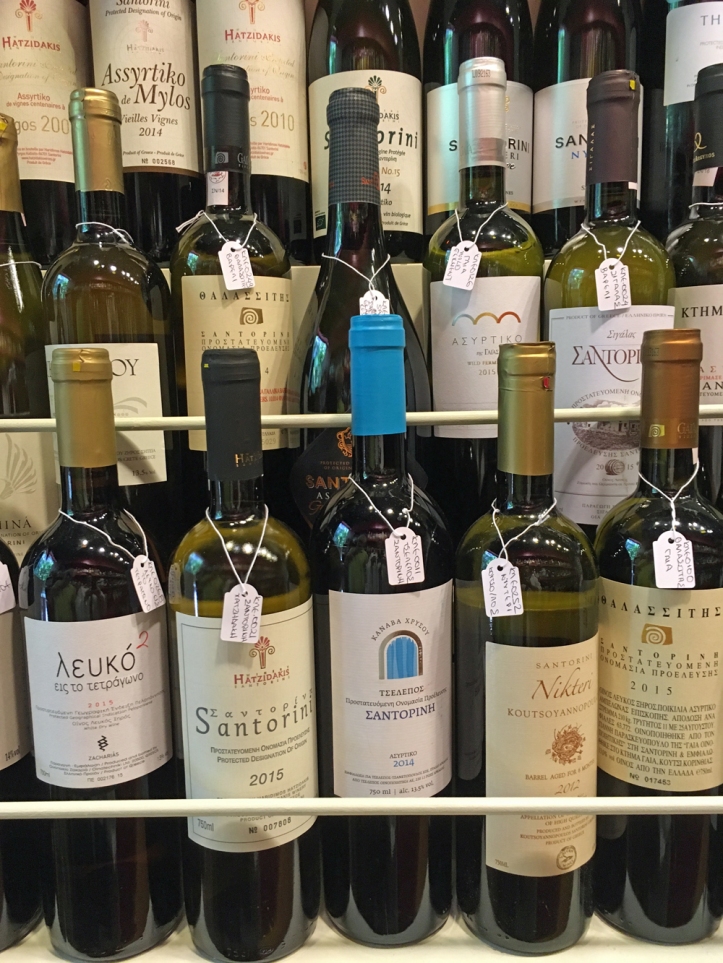Since we have been coming to Greece (well over 30 years now), we have seen a change in local wine – from good/acceptable to excellent/exceptional. Greek vineyards, over the last 20 years or so, have begun to produce great wines that can compete with the world’s best. Many of the wines they produce are made with indigenous grape varieties, most little-known outside of Greece. Another welcome trend seems to be the production of organic wines.
There are over 300 unique Greek grape varieties, many dating back to historic (and even ancient) times. In some cases, these local varietals are being blended with better known grape types (the ubiquitous Chardonnay comes to mind) to produce wines with flavours that would appeal to the international market. Although, I don’t think the vintners here in Greece will entirely succumb to a desire for a uniformity of taste. There seems to be a lot of experimentation in Greek winemaking, a lot of research on defining character and finding the vinticultural potential of these little-known varieties. Naturally, this provides us with a wealth of tastes to explore.
Of the white grape varieties, we have tried and liked wines made from Vidianío, Kountoura Aspri, Malagousia, Aglianico and Asyrtiko. One of my favourite food & drink magazine-style blogs, Serious Eats, reviewed two of these wine grapes. Links to their articles are listed below.
- Vidianó is a white grape from Crete, said to be one of its oldest indigenous varieties. It produces an affordable medium dry white wine that has lovely citrus flavours without being sharp. Since we are fond of all things Cretan, we come back to wines made with this grape again and again. See the article about two Cretan vineyards producing wine with Vidianó on the blog Serious Eats.
- Kountoura Aspri is a white grape not to be confused with Kountoura Mavri, a red grape variety. This white grape is derived from Savatiano, a low acid grape with fruity aromas, grown in Attica and central Greece from which Retsina is made. And before you cringe, some of the new Retsinas are marvellous and don’t at all resemble the harsh resinated (turpintine-like) wines I first sampled here many, many years ago.
- Malagousia is an ancient grape variety that had nearly became extinct until it was rescued and widely cultivated again in the 20th century – revived first in the northern Macedonian town of Drama and is still mainly grown in Macedonia. It is a highly aromatic grape that produces full-bodied elegant wines. One of our favourites – in fact, five (out of five) stars for me.
- Although Aglianico was introduced from southern Italy in modern times, it is thought to have originated in Greece, another of those ancient varieties. Its name is actually an Italian dialectical name for ‘Ellenico’ meaning Greek. In Italy, Aglianico is defined as a red grape and its white version known as Greco di Tufo both of which are known for their rich complexity and ability to produce well aged wines.
- Asyrtiko is a white grape indigenous to the volcanic island of Santorini, now grown in a number of Aegean islands as well as elsewhere in Greece. The variety is one of the few grapes that is known to be immune to the phylloxera virus that devastated the European wine industry in the 19th century. It is now one of the most popular multi-purpose grapes used in blending to create great Greek wines. Alone, it produces crisp, dry white wines although the terroir affects the taste and is best grown on volcanic soils. There are two great articles on Serious Eats, one about the island and its grape and another on its suitability as a great summer wine.
I read somewhere that the confusing and sometimes unpronounceable Greek grape names has put international consumers off. This might be true for mass marketing (along with the desire for a known uniform taste), however, it is likely to have the opposite effect on the connoisseur. With all this grape variety, Greek wines can offer something different, something new – particularly if it has an interesting name attached to it. The wines produced have unique tastes – some drier than others or fruitier or more acidic. Some are better with food, others can be sipped on their own. Well worth trying a few even if you cannot pronounce the varietal name. There are many to choose from.
* * *
The web-site All About Greek Wine is a good place to start for information, although it only lists a few grape varieties. It does, however, give you a good overview of the winemaking regions with a list of some of the individual vineyards and estates.


Great post! I’ve been to Greece at least a dozen times since 1990 and have noticed the same shift in the seriousness of the wine there. From drinkable to competing on the world stage. I love a crisp Greek white! We live in Napa now but trying to stay connected to the broader wine world. Check out our wine country blog: http://www.topochinesvino.com.
LikeLike
I’ m glad you noticed this trend as well. There are so many young vintners out there now willing to invest time to experiment. I predict the wine trade here will do very well on the global market – much like excellent wines from Napa!
LikeLiked by 1 person
I’m starting to import wines from Croatia and Bosnia – another up and comer!
LikeLiked by 1 person
Hi Debi, it is great to see different varieties out there. It is so much fun experimenting.
LikeLike
Hi Glenda, It is an easy task experimenting with wines! With all those varieties and vineyards (large and small) there is much more to taste. Enjoying it immensely. When I get to Australia, I hope to sample some of your country’s excellent wines.
LikeLike
Gone are the days of Retsina!!
LikeLiked by 1 person
True! Long live assyrtiko. Although, retsina does have its place on the Greek table – it cuts through a lot of oil based dishes.
LikeLiked by 1 person
Well, that’s true!
LikeLiked by 1 person
I hope to see some of these in Aussie one day, how fun to try some different varieties. That would wake up the old wine tastebuds that sometimes tire of the old standards.
LikeLike
I can’t say for certain, but I would think with the huge Greek community in Australia, some of these would be available. However, you’ve got some exceptional home grown wines where you are.
LikeLike
I. Hope these make their way to the US!!!
LikeLiked by 1 person
Both the Santorini Assyrtiko and the Cretan Vidiano are available in the US (as reviewed by California based blog Serious Eats). I wouldn’t be surprised if more Greek wines were also available, but it is good to sample them in Greece and better yet to do a wine tour. A great vacation idea + great wine.
LikeLike
What an informative post, Debi. I know very little about Greek wines other than I enjoyed them when I visited the islands. I love to save posts like this on my smartphone and refer to them when I’m in a well-stocked wine store. I tend to feel more satisfied with my purchases than when I ask a clerk for help. 🙂
Thanks for taking the time to gather, organize, and publish this info.
LikeLike
We hope to try yet more varieties over the Christmas holidays – perhaps branching into the reds. However, it is our opinion that the whites are where the real Greek stars are at the moment. Would love to travel to visit the vineyards, but may have to save this up for the summer.
LikeLike